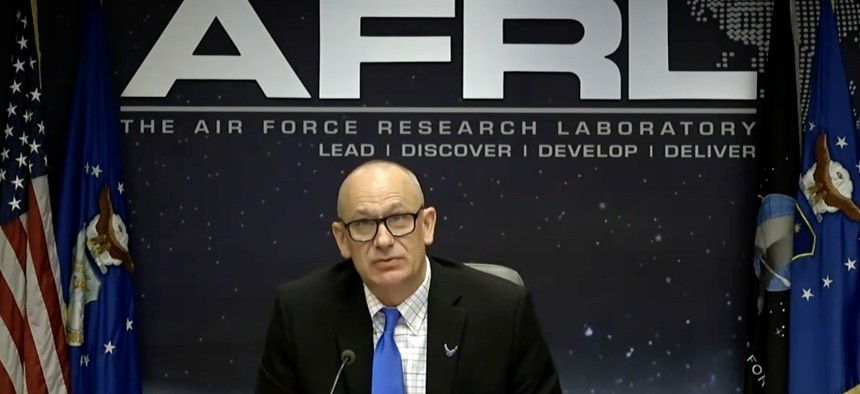Air Force Lab Seeks Higher-Risk, Higher-Reward Breakthroughs
At the Defense One Tech Summit, AFRL's tech chief says the lab wants to answer science questions that have never been asked.
The United States is behind on hypersonics, and big science questions loom on delivery of supplies via rocket ships, but the government has finally adopted a risk-tolerant approach to science and technology experimentation that will allow big breakthroughs in the future, the chief technologist at the Air Force Research Lab said.
Speaking at the 8th annual Defense One Tech Summit, Timothy Bunning, chief technical officer for the AFRL, said the lab is using simulation and virtual environments to a great extent on advanced hypersonic weapons. But while the U.S. is making progress, it still lacks the testing ranges necessary to move as quickly as it wants to.
“We don't have what we need to maybe operate at a speed of relevance right now,” he said.
Bunning isn’t the first Defense Department science and technology official to mention the lack of adequate test ranges for development of hypersonics. Even after the United States inked a deal with Australia in 2019 to co-experiment, the range issue “is not solved. You know, we had a recent scientific advisory board examination of a hypersonics program and…they came back and said, that's the No. 1 threat right now to the portfolio.”
The U.S. is behind China and Russia in fielding advanced hypersonic weapons; Russia is actively using such weapons in Ukraine. At the same time, the U.S. has poured itself into various research efforts, some of which have panned out better than others.
But Bunning cautioned that reading too much into “failures” could put the U.S. back in the position it was in 2012, when it first pivoted away from hypersonic research and development following another “failure,” allowing that research gap with China and Russia to emerge.
“These are complex systems, and things go wrong. And we have to be tolerant of that failure. We certainly know the other side is doing lots of tests, and they fail all the time and maybe don't have the political pressure, public pressure, negative pressure, that comes along with the test.”
And, he said, military leaders and lawmakers are finally in a position to support ambitious experimentation. “I think there's a recognition, you know, that we're coming out of an…era where we could do what we wanted in permissive environments…therefore, we need to change the kit that we have. And it's gonna take some development of the concepts, evolvement of the technologies, and with that comes the need to do things with a risk posture that's maybe a little bit different than what we had, you know, say 10 years ago. So our interactions with Congress have been very, very positive.”
The lab is also moving efforts in aerial swams and networked warfare to the Air Force to become programs of record.
One of the lab’s initiatives that’s still in the earliest stages, dubbed Rocket Cargo, focuses on using hypersonic technology to move of key supplies, cutting the time it takes to move weapons and hardware from one point of the globe to another down from days to hours.
“We’ve broken the problem down into technical components, and we're really trying to do proof of concept experimentation of real world as well as in the computer,” he said.
The lab is partnering with SpaceX on the research effort, which has a way to go before it receives a green light—in large part because it seeks answers to questions that have never been asked before. “We can throw out a big cargo pack out the back of a C-130 flying at 10,000 feet with parachute, and it drops. Well, can I drop something out of a rocket that's traveling Mach, you know, five? Something that's a heck of a lot bigger 100 tons? … How would we go about reconstituting a landing pad that had the right performance specs in a short period of time? Is there new technology that can do that?”
The lab is still working to determine if the idea is truly feasible, he said. But asking those questions is a “high-risk, high-payoff activity.”
“What the teams are trying to do is, you know, ask the ‘what if?’ questions. Can this be done…with quantitative measures? As the teams come together at some point, we'll assess.”
Bunning’s session will air Wednesday at noon.
NEXT STORY: We’re Still Arguing Over Women in the Military?




